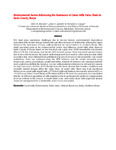Environmental Factors Influencing the Sustenance of Camel Milk Value Chain in Isiolo County, Kenya

View/
Date
2021-06Author
Machan, Steve N.
Agwata, Jones F.
Oguge, Nicholas O.
Metadata
Show full item recordAbstract
Dry land areas experience challenges due to various factors, environmental degradation associated with climate change related risks and other stressors of biodiversity, which pose major threats to the sustenance of camel milk production for most residents in northern Kenya. This study examined some of the environmental factors that influence camel milk value chain in Isiolo County of Kenya based on two hundred and eighty-four (284) households interviewed, fifteen (15) key informants, and twenty (20) focused groups. Semi-structured questionnaires, face to face interviews and the mixed method approach were used to collect primary data while secondary data were obtained from published and grey literature in relevant public and private institutions. Data was analyzed using the SPSS software and the results presented using frequencies, means, percentages, graphs and tables. Analysis of variance and regression analysis were applied to establish the variance in camel milk production between the wet and dry seasons for four years from 2016 to 2019. Results from the study showed that weather conditions and available natural forages affect the value chain of camel milk. There was high significant difference in camel milk supply with +2728.6 of milk sold between wet and dry seasons at P(0.05) <0.025 using Fisher’s Least Standard Deviation (LSD) at 5% level. In conclusion, it is established that the variations in quantities of milk supplied is due to prolonged dry spells and inappropriate land use systems in the County. A modernized camel milk value chain with improved natural resources management for a sustainable system is recommended.
